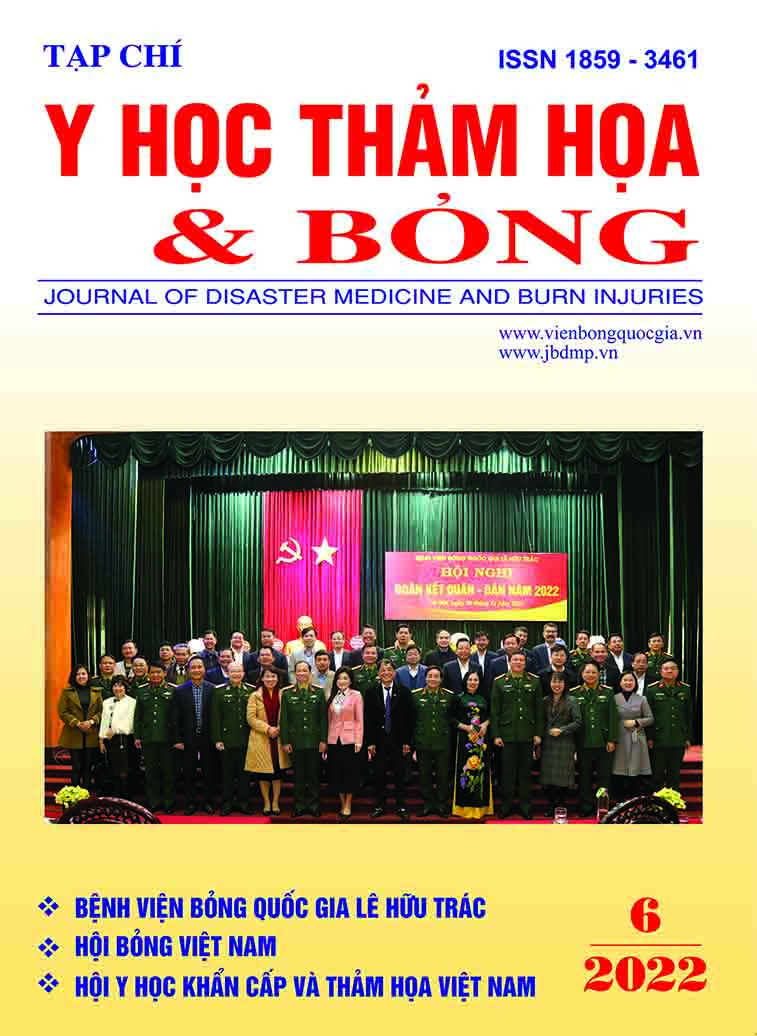Characteristics of electrolyte disturbances at admission and related factors in severe burn patient
Main Article Content
Abstract
This study aimed to evaluate characteristics of electrolyte disturbances at admission and related factors in the severe burn patient. A retrospective study was carried out on 241 burn patients with burn extent > 20% of BSA, hospitalized at Vietnam National Burn Hospital for 2 years (2021 - 2022) with treatment duration > 3 days. The results showed that Electrolyte disturbances at hospital admission were mainly due to hyponatremia and hypocalcemia (51.04% and 35.27%).
There were 7.05% cases of hyperkalemia. Hyperkalemia in patients with burn extent ≥ 50% TBSA, deep burn area ≥ 20% TBSA was remarkably higher than in patients with burn area < 50% TBSA, deep burn area < 20% TBSA (p < 0.05). Hypocalcaemia was more common in electric burn patients than in other cases, the difference was statistically significant (p = 0.004). The electrical burn agent and deep burn area were independently related to hypocalcemia on admission. While the area of deep burns was independently related to potassium disturbances on admission.
Article Details
Keywords
Electrolyte disturbances, burns
References
2. Shen S., Ham T., Fleming E.J.N.E.J.M. (1943) Mechanism and complications of hemoglobinuria in patients with thermal burns: spherocytosis and increased osmotic fragility of red blood cells. 229, 703-713.
3. Magner P., Robinson L., Halperin R., et al. (1988) The plasma potassium concentration in metabolic acidosis: a re-evaluation. 11 (3), 220-224.
4. Funk G.-C., Lindner G., Druml W., et al. (2010) Incidence and prognosis of dysnatremias present on ICU admission. Intensive care medicine, 36, 304-311.
5. Wald R., Jaber B. L., Price L. L., et al. (2010) Impact of hospital-associated hyponatremia on selected outcomes. Archives of internal medicine, 170 (3), 294-302.
6. Waikar S. S., Mount D. B., Curhan G. C. (2009) Mortality after hospitalization with mild, moderate, and severe hyponatremia. The American journal of medicine, 122 (9), 857-865.
7. Hollander-Rodriguez J. C., Calvert J. F. J. A. f. p. (2006) Hyperkalemia. 73 (2), 283-290.
8. Rotheray K. R., Cattermole G. N. (2010) Rosen's emergency medicine: concepts and clinical practice.
9. Schaner P. J., Brown R. L., Gunther R. C., et al. (1969) Succinylcholine-induced hyperkalemia in burned patients-1. 48 (5), 764-770.
10. Navarrete N. J. B. (2018) Hyperkalemia in electrical burns: A retrospective study in Colombia. 44 (4), 941-946.
11. Cancio L., Mozingo D., Pruitt J. J. J. o. C. I. (1997) Administering effective emergency care for severe thermal injuries: Initial strategies for respiratory support, fluid resuscitation, wound care. 12 (2), 85-95.


